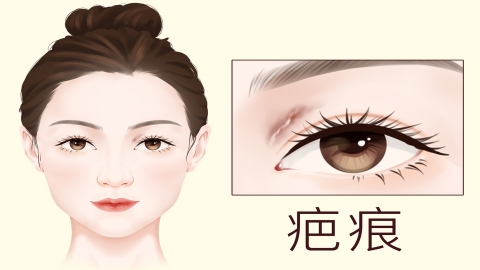What does it mean if a scar on the corner of the eye turns white?
Generally, whitening of a scar at the corner of the eye may be related to completed scar repair, scar tissue edema, pigment loss, localized infection, or vitiligo. If discomfort occurs, timely medical consultation is recommended for symptomatic treatment under a physician's guidance. Detailed explanations are as follows:

1. Completed Scar Repair
For old scars, localized whitening might indicate that the scar repair has been largely completed. At this stage, vascular engorgement and dilation caused by hyperplasia gradually subside, and blood circulation decreases, resulting in a whitish appearance. This typically indicates that the scar has stabilized in shape, will not continue to enlarge, and may gradually contract and be absorbed over time.
2. Scar Tissue Edema
The corner of the eye is prone to accumulation of tears, which may soak the scar tissue, causing edema and whitening. This condition typically does not pose serious health risks, but it is important to keep the area dry and avoid further irritation.
3. Pigment Loss
Inflammatory responses after skin injury may damage melanocytes or impair their function, leading to skin depigmentation and whitening of the scar at the corner of the eye. It is often accompanied by uneven skin tone and texture changes. Improvement can be achieved through laser whitening treatments as advised by a physician. This treatment uses photothermal energy generated by laser pulses to break down subcutaneous melanin into small pigment particles, which are then expelled from the body, achieving a lightening and whitening effect. The typical reference price for laser whitening is 500-1000 per session, with visible improvement generally occurring within 7-15 days. Possible side effects include localized redness, swelling, and post-inflammatory hyperpigmentation.
4. Localized Infection
In the early stages of scar formation, whitening might indicate a localized infection. This could be due to pus accumulation beneath the scar tissue, causing the whitish appearance. It is often accompanied by symptoms such as itching and pain. Treatment may include medications like amoxicillin capsules, cefixime dispersible tablets, or roxithromycin capsules, as directed by a physician.
5. Vitiligo
Vitiligo may be caused by genetic factors, trauma, or immune system dysfunction. During its progression, melanocytes may gradually disappear, potentially leading to white patches on the skin. It is typically accompanied by symptoms such as depigmented patches and alopecia. Treatment options include moisturizing skin ointments, tacrolimus ointment, and dexamethasone cream, as directed by a physician.
It is recommended to use mild cleansers to wash the scar and surrounding skin regularly to prevent bacterial growth and infection. After washing, gently pat the area dry without excessive rubbing.




